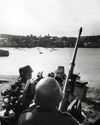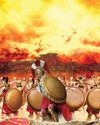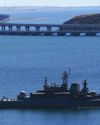Prøve GULL - Gratis
BRUSHES WITH ARMAGEDDON
History of War
|Issue 138
Humanity came close to self-annihilation with the Cuban Missile Crisis, Broken Arrows’ and other nuclear near misses
-

By the early 1960s the US and the USSR were rival superpowers with enough nuclear weapons to wipe one another off the face of the earth, along with everybody else. In theory this stand-off kept the peace, but in late 1962 humanity found itself facing Armageddon.
On 14 October, a US U-2 spy plane photographed Soviet nuclear missile sites being constructed on communist Cuba, less than 100 miles (160km) from Florida. On 22 October, US President John F Kennedy revealed the extent of the crisis in a TV address to the nation. "My fellow citizens," he said, "within the past week, unmistakable evidence has established the fact that a series of offensive missile sites is now in preparation on [Cuba].
"Several... include medium-range ballistic missiles, capable of carrying a nuclear warhead... more than 1,000 miles [making them] capable of striking Washington, DC...or any other city in the southeastern part of the United States. It shall be the policy of this nation to regard any nuclear missile launched from Cuba against any nation in the Western Hemisphere as an attack by the Soviet Union on the United States, requiring a full retaliatory response upon the Soviet Union." For a week, the world held its breath as Kennedy and Soviet President Nikita Khrushchev sought a diplomatic solution to the crisis. In the end, it took a secret deal to pull the world back from the brink. The USSR would remove the missiles from Cuba in return for the US removing the missiles it had pointed at the Soviet Union from Turkey. A nuclear holocaust had been averted, but only just.
Denne historien er fra Issue 138-utgaven av History of War.
Abonner på Magzter GOLD for å få tilgang til tusenvis av kuraterte premiumhistorier og over 9000 magasiner og aviser.
Allerede abonnent? Logg på
FLERE HISTORIER FRA History of War

History of War
BATTLE FOR THE CHANNEL ISLANDS
In 1945, the Allies were ready with a daring amphibious operation to liberate Jersey and Guernsey by force
8 mins
Issue 152

History of War
THE BOYNE
Three crowns were on the line when two kings met in Ireland on a sweltering summer's day
11 mins
Issue 152

History of War
PARIS DAVIS
This pioneering member of the United States Army Special Forces received long-overdue recognition for his heroism rescuing comrades during the Vietnam War
6 mins
Issue 152

History of War
FALL OF THE SPARTANS
The powerful Greek city-state overreached itself and saw its influence decline as it failed to integrate conquered territories
4 mins
Issue 152

History of War
MASTERS OF THE SKIES
From rapidly evolving roles to new technologies, historian and airpower expert John Curatola discusses how fighter planes shaped the Second World War
9 mins
Issue 152

History of War
TEA WITH TRAITORS
A progressive educator celebrated her birthday with a tea party for dissident friends – unaware that a Gestapo informant was among them
9 mins
Issue 152

History of War
CHURCHILL IN THE TRENCHES
How Britain's future war leader earned respect and redemption on the Western Front
13 mins
Issue 152

History of War
"MORE DANGEROUS THAN THE 1950S"
Do we need to relearn the Cold War's fear of mutually assured destruction in our unregulated nuclear landscape?
3 mins
Issue 152

History of War
CRIMEA IN THE CROSSHAIRS
The Black Sea peninsular has been coveted by rival interests for centuries, with the current Russian occupation motivated by several factors
5 mins
Issue 152

History of War
ON THE BRINK
Any conflict between the US and China would almost certainly see the American mainland come under direct attack
3 mins
Issue 152
Listen
Translate
Change font size

